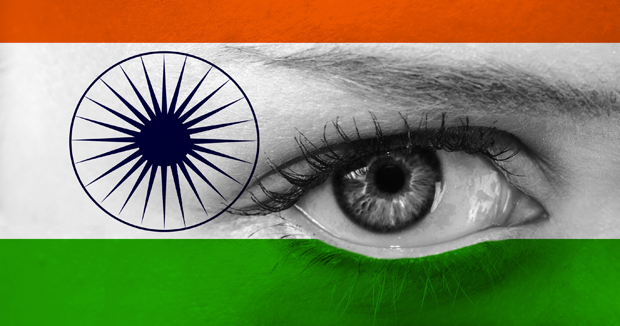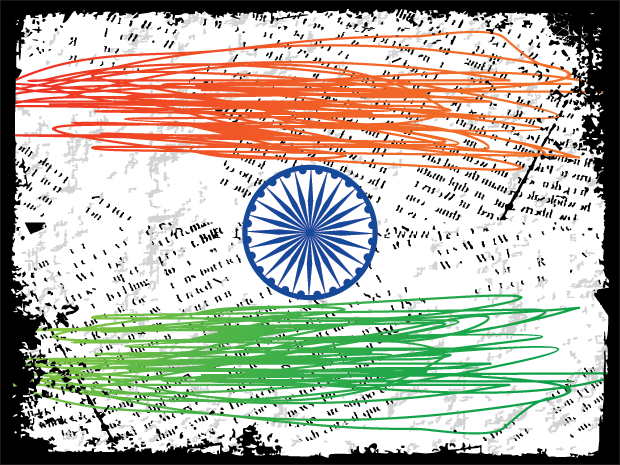Index relies entirely on the support of donors and readers to do its work.
Help us keep amplifying censored voices today.

(Illustration: Shutterstock)
The social media experience which came across as a liberating tool for women, was often equated with a living room where one could voice opinions in public sphere. However, of late, a series of incidents have sounded a note of caution against the euphoria around social media. It has been compared to a street where women are abused, threatened, ogled at, rebuked, only virtually.
The situation plugs American academic Lawrence Lessig’s contention, “Cyberspace is something we build. Who knows how much of the real world is socially constructed? But, one thing is certain, cyberspace is socially constructed.”
While the online abuse faced by British activist Caroline Criado Perez, who led a successful campaign to have a woman on the £10 note first grabbed the news headlines, the scene in India isn’t too different. Even with a limited penetration of the internet, sexist abuse has become a tool to muzzle voices of independent women.
Things seem to have heated even more in the run up to poll season in India, where female Twitter users have increasingly become a subject of sexist abuse.
The abuse over political tweets isn’t a new phenomenon however; it has significantly gone up.
When Kavita Krishnan, feminist activist and political commentator recently opposed the induction of controversial chief of a right-wing outfit, who led an attack on women in a pub, she drew a barrage of abuse. Responses were replete with sexist comments and death threats. Additionally, there were many others who endorsed rape threats directed at her.
Krishnan, a Communist Party politbureau member, is also quick to point out that online abuse grows more vicious when she voices her political opinions. Threats directed at her have ranged from sexual assault to mutilation of genitals. Furthermore, anonymity granted to users on social media platforms has drawn threats directed at her mother too.
Female Twitter users are not always abused through words, morphed photographs with captions are also circulated by users online.
When actor, activist Gul Panag, who has been an assertive voice on Twitter recently threw herself into the political ring by contesting on a Common Man Party ticket, many users began posting her morphed photographs in lingerie with strategically placed accessories.
However, in an encouraging trend, trolls were soon outweighed by users who voiced support for her.
Female journalists, who express opinions on political issues, international affairs, among other topics considered anathema to the right wing, are also subjected to scathing Twitter attacks.
Sagarika Ghose, a senior Indian journalist who coined the term “Internet Hindus” writes, “As a television journalist, I get a daily dose of abuse on Twitter, an exercise in character-building endurance. Some examples: “Bitch, you deserve to be stripped and raped publicly.” “why u r not covering Assam riots?”, she writes.
Condescension is also evident in responses journalists receive which question their professional integrity. In Ghose’s case, the responses underlined how topics often considered anathema to the Hindu right, ended up pointing fingers at her journalistic integrity, accusing her of trivialising events.
With the poll bugle being sounded in country, female politicians active on Twitter have been subjected to scornful tweets, often threatening their family members. For instance, Priyanka Chaturvedi, a Congress party spokesperson tweeted, “Ladies you attack me is fine, bring on the love I say but don’t cross the crass line by dragging my parents/kids into this. Thanks. (sic)”
The reason for misogynistic abuse has little to do with what women talk about, rather it is the idea of a vocal and independent woman reclaiming online space which makes users abusive. Additionally, if a woman is vocal in opposing what may seem offensive to the right-wing, she becomes the target. Even opposing misogynistic values in seemingly innocuous statements draws in vicious abuse.
In December 2013, a researcher on caste and gender Arpita Phukan Biswas was subjected to rape threats when she protested against Indian singer Palash Sen’s misogynistic remarks at a cultural festival.
She initially let it go but as threats grew worse, she began tweeting about her harrowing experience and wrote a post on Facebook.
While many branded her Feminazi, others discussed how she should be made to shut up by rape and beating as she wasn’t having enough.
Politics, religion, feminism and sexuality are among the topics which strike more attention, deduces Anja Kovacs who heads the Internet Democracy Project, which recently did a study on women and verbal online abuse in India.
The study further notes that many online users expect women to be servile while others believe they have the right to discipline women through coercive measures resulting in blatant misogyny at play.
Kovacs rightly draws the metaphor of street for the internet.
“Internet is just like a street. Like women face sexual harassment on street, they do on the internet as well. Misogyny is evident in verbal online abuse on platforms like Twitter,” she says.
While sexism has been used as a tool to attack women on public spaces and muzzle their voices, it is time users come to each others’ rescue to reclaim spaces. Despite similarities between street and the internet, the weapons on the latter with both men and women are the same– the keyboard. The best way to counter avalanche of vicious sexist abuse is by witticism.
Kovacs believes setting up a strong online community of support is a way to counter abusive twitter users. “Being called ‘bitch, slut, whore’ is misogyny at play. And it cannot be eradicated and countered by legal measures”.
Similarly, a prolific Twitter user Vidyut Kale (@vidyut) makes it a point to never block anyone who trolls her. In fact, she believes in rolling up her sleeves and taking on the trolls. As a result, many trolls have ended up blocking her.
Perhaps, it is time we take a few steps back from the euphoria surrounding the liberating nature of the internet and critically examine social media spaces where virtual reality mirrors the real ugly one. There is a need to look at social media spaces as regions upholding patriarchal and misogynistic values and address challenges thereof.
This article was posted on April 1, 2014 at indexoncensorship.org

(Photo illustration: Shutterstock)
Shapoorjee Sorabjee, the first historian of cricket in India, had cautioned more than a century ago in 1897- “… to expect all political difference to disappear or all available self-interests to be foregone on the institution of cricket relations is to live in a fool’s paradise.” Sorabjee’s words echo loudly in the persecution of 67 Kashmiri Muslim students in the city of Meerut on March 6. Historian Ramachandra Guha’s statement- “post-independence, cricket was equated with patriotic virtue”, echoes louder.
These local college students had cheered the Pakistan cricket team which trounced India in a cricket tournament. In normal circumstances, cheering a team would not have been considered perfidious or criminal. Unless of course one is thrown back to 1945, when Orwell acerbically noted that there’s nothing like certain spectator sports to add to the fund of ill-will between nations and their populations. Or, more recently, to the times of Norman Tebbit and David Blunkett for whom a cricket match was the perfect crucible to test one’s loyalty to his country.
But Indo-Pak cricket matches are anything but “normal”. On the Indian side of the border, they are nothing but battles to be won, and once victory has been achieved, to be celebrated by humiliating, vilifying and demonising “the other”, that is, Muslims. And when there are Kashmiri Muslims, the viciousness is increased manifold.
So it happened that these students were charged with sedition, which under Indian criminal law, is equivalent to treason, and carries a maximum sentence of life imprisonment. The Bharatiya Janata Party (BJP), which in its present incarnation can give the British National Party and United Kingdom Independence Party lessons in jingoism and xenophobia, quickly bared its fangs, and raised a din about bringing these “terrorist” students to justice. Not unsurprising, when its senior leader and a proclaimed patron of cricket, states with pride that cricketing nationalism is an integral aspect of a person’s national identity. When the charges were withdrawn following a loud backlash, the BJP rushed to the election commission alleging that the ruling party in Uttar Pradesh (where Meerut is located) was violating the poll code by this act of pandering to anti-national Muslims.
This sordid affair brings back memories of March 2003. The police top brass in Calcutta had planned how to prevent Muslims from supporting Pakistan during the World Cup quarter-final against India. When India won, a precedent of sorts was set- the army chief, the prime minister and deputy prime minister rang up the players and congratulated them. Such praise is usually reserved for occasions when the team wins the tournament, and not a particular match. In Ahmedabad, riots broke out when Muslims were prevented from celebrating India’s win.
It is easy to excoriate the Hindu right wing parties, but rabid Islamophobia is par for the course in so far as they are concerned. The Meerut incident demonstrates a new use of sedition initiated not by the usual suspects but by a state government which professes to be secular.
An incident of 2010 brings out the novelty factor. Arundhati Roy had criticised the government for decades of brazen civil rights violations in Kashmir, and demanded that the people of the disputed territory be allowed to exercise their right of self-determination. The “patriotic” Hindu right went ballistic, and demanded that she be tried for sedition and also deported. Charges were pressed, and even some sections of the media were complicit in an all-out attack against her, as this report details.
But Meerut is not the bastion of the rabid fundamentalists, so what could have happened? The answer is found in the antecedents of the college administrators who went to the police in the first place. The rector and chancellor are a retired police officer and army general, respectively. Representatives and agents of the Indian state, which has always used the sedition law to squelch dissent and perpetrate impunity. Almost like Omar Abdullah, the chief minister of the state of Jammu & Kashmir, who exposed his real stance by calling the charges harsh and unacceptable, and in the same breath, labelled the students’ actions as “wrong and misguided”. But more striking is the cynical opportunism by the government of Uttar Pradesh. It had done nothing to stop the bloody riots in Muzaffarnagar last year but beat the tin drum of it being “secular” to the core. Taking it one step further, it used a law described as “objectionable and obnoxious” by none less than India’s first prime minister Jawaharlal Nehru, to curry favour with the majority Hindu constituency on the eve of national elections.
Whoever thought that the odious doesn’t have its productive uses?
This article was posted on March 27, 2014 at indexoncensorship.org

Step back to 23 February. In Delhi, the caretaker of Siddharth Varadarajan’s house was roughed up by goons who left a chilling threat. “Ask your employer to hold his tongue on television,” they thundered. Professor Nandini Sundar, Varadarajan’s wife, wasn’t spared either. A threat was left for her, because she had taken a state government to court for its use of militia against its own citizens.
“Where we needed investigations, we made announcements,” lamented veteran Indian journalist P. Sainath. His stinging rebuke was against the mainstream media’s deafening silence in the face of one of the worst agrarian crisis India had faced, back in 2008. In light of this code of silence, the reasons for the incident of 23 February become clear. Compare the Indian media’s coverage of that incident with the blitzkrieg of apoplexy which greeted Aam Aadmi Party chief Arvind Kejriwal’s threat to jail journalists whom he considered to be corrupt (sold out to the Bharatiya Janata Party (BJP) – against whom he has launched an all-out war), and things fall into perspective. In case of the former, there were the usual noises and clichéd responses– condemning growing intolerance, bemoaning the rapidly shrinking space of freedom of expression, so on and so forth. The latter — Kejriwal’s threat — was greeted with a vehemence and unanimity rarely seen in the Indian media.
Both Varadarajan, former editor of The Hindu, one of India’s most respected newspapers, and Professor Sundar, sociologist, academician and civil liberties activist, have earned a considerable degree of notoriety and opprobrium, which only seem to be increasing of late. The choicest invectives are reserved for them, especially for Varadarajan. Anti-national, traitors, and shameless espousers of terrorism — the list goes on. The reason? They have been trenchant critics of the aforementioned “announcement”, as well as of proclamations of innocence by the government of Chhattisgarh state, and by the BJP’s prime ministerial candidate and his humongous band of acolytes.
Chhattisgarh, a state in central India, has been the hotbed of insurgency, the causes of which are too many and complex to be addressed here. However, the BJP-ruled government had a novel solution — raise a band of state-sponsored militia, arm them to the teeth, grant them carte blanche powers to kill, rape, maim, plunder, and unleash them on the insurgents. Sundar has been a vocal critic of such “atrocious” “counter-insurgency measures” and in 2011, acting upon her petition, India’s Supreme Court outlawed the government’s policy. The court did not mince words in its censure of a government killing its own citizens in cold blood. The government has not taken too kindly to such strictures — while continuing to subvert the court’s order, it has also accused Sundar of complicity with the insurgents.
Varadarajan stands accused of and vilified for more egregious lying. He has demonstrated the temerity to tirelessly challenge one of the most vociferous of “announcements” — that Narendra Modi has been granted a “clean chit”, meaning exoneration from a civil or criminal charge, over his role in the bloodcurdling pogrom against Muslims in Gujarat 2002. Modi’s piece de resistance of exculpatory evidence is the report of an investigation team which declared that he had no role to play in either instigating the riots, or as Chief Minister of Gujarat, directing the police and administration under his watch to go for the kill.
Varadarajan has, with staggering perseverance, been taking a sledgehammer to this impunity. Be it blowing holes in the official reason being touted, editing a collection of essays nailing the official lies, speaking about the manufacturing of “truth” and consent by a craven media, speaking up for a scrupulously researched book which exposes the investigation and “clean chit” as travesty, or adhering to his journalistic principles and refusing to kowtow to the “Modi wave” — he has left no stone unturned. And paid for it, too. In fact, one of the reasons for his resignation from as venerated a paper as The Hindu was his staunch refusal to act as a megaphone for Modi’s propaganda.
Dissent and accountability are anathema to Modi. Especially if they threaten to rip apart his assiduously crafted and forcefully propagated image of exemplary governance, and of course, his squeaky clean hands in so far as the 2002 pogrom was concerned. A 2003 documentary was banned by censors (led by a Gujarat BJP politician) because “it shows the government and police in a bad light”. Journalist Manoj Shinde had to pay with jail time on charges of sedition for mustering the audacity to criticise Modi’s handling of massive floods in 2006. And only three days ago, the police in Gujarat’s capital Ahmedabad ensured that a documentary challenging the “Modi-fied truth” did not get to be screened.
This article was published on 26 March 2014 at indexoncensorship.org
Index on Censorship, in association with Doughty Street Chambers, invites you to attend our high-level panel discussion asking who runs the internet?
At a moment when the revelations on NSA and GCHQ mass surveillance are opening up a wide debate about our digital freedoms, our panel will discuss how free the net is today, and the main challenges that lie ahead. In the next couple of years, major international summits will debate new rules on internet governance, and whether to adopt a top-down approach as favoured by China and Russia, or maintain a more open, multistakeholder networked approach. Meanwhile, from the EU to Brazil, reactions to the Snowden’s revelations of mass snooping suggest there is a growing risk of fragmentation of the internet, with calls for forced local hosting of data.
We are delighted to be hosting speakers:
Bill Echikson – Head of Free Expression EMEA, Google
Richard Allan – Head of Europe, Middle East and Africa, Facebook
Tusha Mittal – formerly a correspondent for Tehelka and currently a Fellow at the Reuters Institute, Oxford University
Kirsty Hughes – CEO, Index on Censorship
The panel will make short introductory remarks ensuring plenty of time for a lively Q&A session.
The event will be held at Doughty Street Chambers (53-54 Doughty St, London WC1N 2LS) on Wednesday 2nd April 6-7.30pm, followed by a drinks reception. To RSVP please fill in your details here. If you have any questions please contact Fiona Bradley ([email protected]).